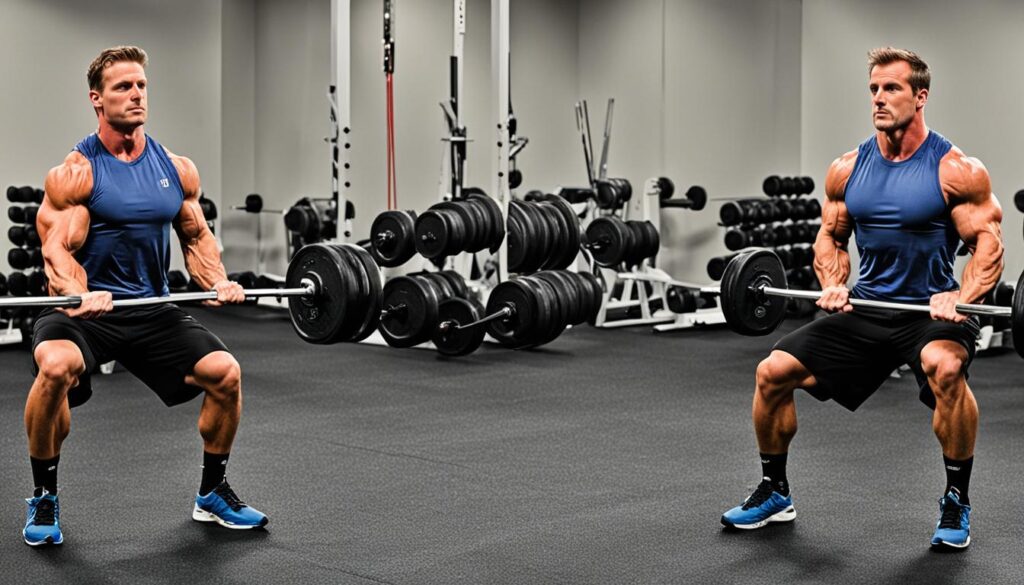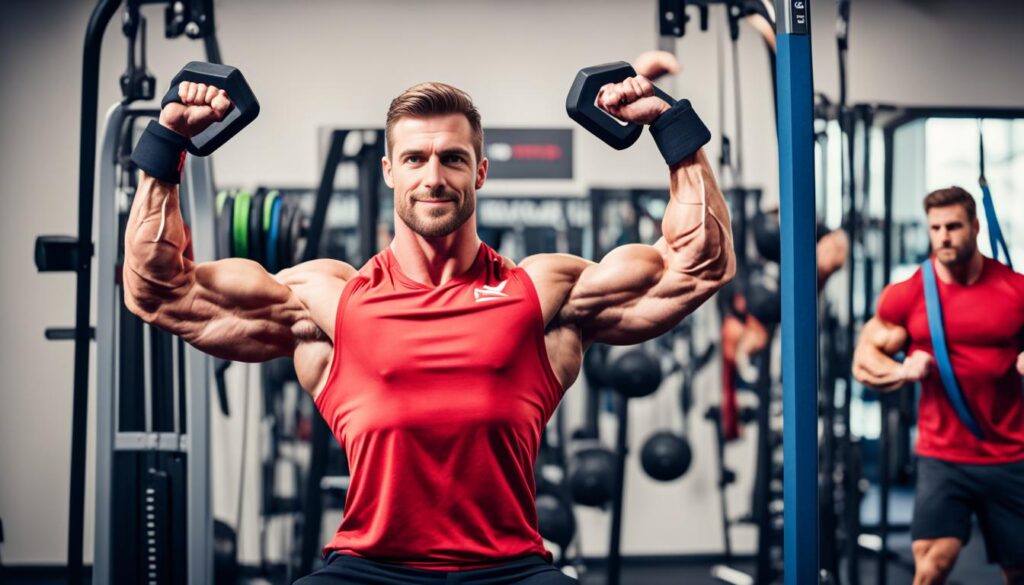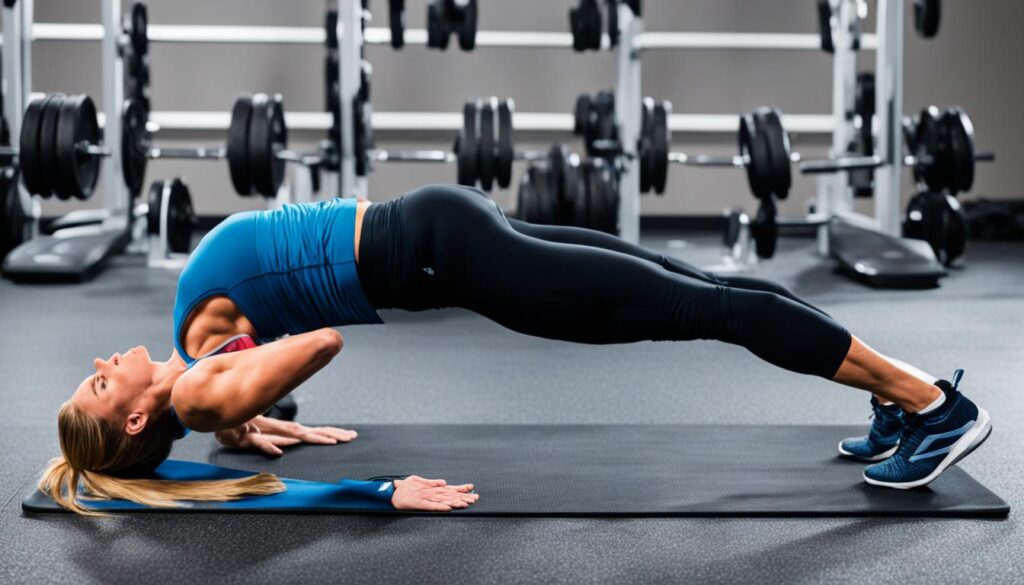Unleash your full fitness potential by embracing the power of antagonistic muscles. With over 600 muscles in the human body, each playing a vital role in daily functions1, it’s crucial to understand how these opposing muscle groups work together to achieve maximum gains.
The major muscle groups typically organized in physical training include the chest, back (including lats and rhomboids), legs (including glutes, hamstrings, and quads), shoulders, triceps, biceps, and core muscles1. Training these major muscle groups is essential as a means to also train secondary and minor muscle groups due to their interconnectedness in strength-building exercises1.
By focusing on antagonistic muscle pairs, such as the chest and back, biceps and triceps, or quadriceps and hamstrings, you can unlock a world of benefits that will transform your fitness journey.
Key Takeaways
- Antagonistic muscles work in opposition to each other, enabling efficient and safe movements.
- Training antagonistic muscle groups together can boost muscle growth, increase overall strength, and save time in the gym.
- Incorporating techniques like supersets and staggered rest periods can optimize the benefits of antagonistic muscle training.
- Selecting the right training split, such as Push/Pull/Legs or Upper/Lower, can ensure comprehensive coverage of all major muscle groups.
- Proper exercise selection and equipment utilization can further enhance the effectiveness of antagonistic muscle training.
What are Antagonistic Muscles?
Antagonistic muscles are groups of muscles that work in opposition to each other, allowing for efficient and safe joint movements2. When one muscle, known as the agonist, contracts, the opposing muscle, the antagonist, relaxes2. This muscle synergy is crucial for everyday activities, sports, and strength training.
Understanding Opposing Muscle Groups
The most common examples of antagonistic muscle pairs include the biceps and triceps, the quadriceps and hamstrings, and the abductors and adductors3. These opposing muscle groups work together to enable a wide range of joint movements, such as flexion and extension, adduction and abduction, and rotation2.
Agonist muscles are responsible for initiating movement through contraction, while antagonist muscles provide the opposing force to control the movement2. For example, the biceps act as agonists when bending the elbow, while the triceps function as antagonists by straightening the elbow3.
Understanding the interplay between agonist and antagonist muscles is key to developing a balanced, strong physique3. Targeting these opposing muscle groups can significantly enhance joint stability, power, and overall fitness4.
“The triceps muscle in the upper arm acts as an antagonist to the biceps muscle.”2
Similarly, the gastrocnemius muscle in the calf functions as an agonist when bending the leg at the knee, but it becomes an antagonist when straightening the leg2. The quadriceps muscles in the upper leg serve as antagonists when lifting the leg (flexing the hip) and become agonists when relaxing the leg down towards the ground (extending the hip)2.
| Antagonistic Muscle Pairs | Joint Movement |
|---|---|
| Biceps and Triceps | Elbow Flexion and Extension |
| Quadriceps and Hamstrings | Knee Flexion and Extension |
| Abductors and Adductors | Leg Abduction and Adduction |
| Pectoralis Major and Latissimus Dorsi | Shoulder Flexion and Extension |
| Deltoids and Trapezius | Shoulder Abduction and Adduction |
Recognizing these antagonistic muscle pairs and understanding their roles in joint movements is essential for designing effective training programs and achieving balanced muscular development342.
Benefits of Training Antagonistic Muscles
Incorporating antagonistic muscle training into your workout routine can bring about a multitude of benefits. By targeting opposing muscle groups, you can maintain muscle balance and joint stability, reducing the risk of imbalances and injuries5. This coordinated action of agonists and antagonists also optimizes strength development, leading to more comprehensive and balanced muscle growth5.
Furthermore, training antagonistic muscles can boost the overall efficiency of your workouts6. Scientific studies demonstrate that alternating opposing exercises can increase strength and power compared to traditional training methods6. By working opposing muscle groups simultaneously, you can reduce exercise time by up to 50%, allowing for more effective workouts in less time6.
The benefits of antagonistic training extend beyond just muscle balance and strength6. Working opposing muscle groups can also lead to increased muscle hypertrophy and improved blood flow, reducing lactic acid buildup and muscular fatigue6. This enhanced muscle efficiency and time-saving aspect of antagonistic training make it a valuable tool for athletes and fitness enthusiasts alike7.
| Benefit | Description |
|---|---|
| Muscle Balance and Joint Stability | Engaging both agonist and antagonist muscles helps prevent muscle imbalances and reduce the risk of injury. |
| Strength and Power Development | The coordinated action of opposing muscle groups optimizes strength and power development. |
| Workout Efficiency | Antagonistic training allows for more effective workouts in less time, with reduced exercise time by up to 50%. |
| Muscle Hypertrophy and Blood Flow | Working opposing muscle groups can lead to increased muscle growth and improved blood circulation, reducing fatigue. |
In conclusion, the benefits of training antagonistic muscles are numerous and impactful. By incorporating this approach into your fitness routine, you can achieve a more balanced, efficient, and effective workout, ultimately leading to greater gains and improved overall physical performance756.
Supersets: An Effective Technique
Supersets, a dynamic training approach, offer an efficient and time-saving strategy for building muscle and maximizing gains. The essence of supersets lies in performing two exercises consecutively with minimal rest, allowing one muscle group to work while the other rests. This technique not only boosts muscle growth but also streamlines workout duration, making it an attractive option for fitness enthusiasts pressed for time.
Time-Saving and Muscle Growth
Superset training has been confirmed as more time efficient than traditional set training, making it a valuable technique for busy individuals in the fitness industry8. World-class bodybuilders such as Dave Draper and Arnold Schwarzenegger favored superset training during the 60s and 70s Golden Era, showcasing its effectiveness8. By reducing or eliminating rest intervals between paired exercises, typically taking about 10 to 20 seconds to move to the next exercise station, supersetting allows completing the same workload in less time8. This efficiency in superset training, combined with its ability to target opposing muscle groups, has made it a go-to strategy for optimizing muscle hypertrophy.
Conventional weight training typically involves 6-12 repetitions in a series, followed by a rest interval of one to three minutes9. In contrast, supersets involve performing two exercises in a row with virtually no rest in between exercises, making them an excellent technique for muscular hypertrophy, especially for individuals short on time9.
“Superset training is a game-changer for busy fitness enthusiasts. It allows me to pack a punch in less time, delivering impressive muscle growth while optimizing my workout schedule.”
Antagonistic muscle supersets, where opposing muscle groups are worked consecutively, stand out as one of the most popular and effective types of superset training in the fitness and bodybuilding industry8. This approach, such as pairing biceps curls with triceps extensions, keeps one muscle group engaged while the opposing muscle group rests, maximizing the time under tension and driving muscle development.
By incorporating supersets into your workout routine, you can unlock the benefits of time-efficient training and accelerate your muscle-building journey, all while streamlining your fitness regimen1089.
Agonist-Antagonist Supersets
When it comes to maximizing the benefits of your workout, the pairing of agonist and antagonist muscle groups can be a game-changer. Agonist-antagonist supersets, where you alternate between exercises that target opposing muscle groups, offer a unique approach to optimizing your rest periods and enhancing your overall workout performance11.
The key to agonist-antagonist supersets lies in the way they allow one muscle group to rest while the other is engaged. This strategic approach ensures that the resting muscle can recover and replenish its energy stores, enabling you to maintain intensity and volume throughout your workout11. Sample workout pairs could include dumbbell bench press and one-arm rows, front squats with ab wheel, or dips with rope climbs11.
Optimizing Rest Periods
Researchers have found that agonist-antagonist supersets can enhance exercise execution and total training volume compared to traditional sets12. By alternating between agonist and antagonist muscles, you can double the workload per training unit and achieve greater muscle activation and growth12. The recommended rest intervals for agonist-antagonist supersets, such as bench press and pull-ups, are typically 45-60 seconds between sets, with 2 minutes of recovery after the pull-up sets11.
The benefits of agonist-antagonist supersets extend beyond just time efficiency. Studies have shown that this training method can increase work capacity by up to 40% compared to traditional sets12. Additionally, it can enhance the ability to achieve full motor unit activation in the muscles, allowing you to lift heavier weights and ultimately drive greater muscle growth and strength gains12.
“Agonist-antagonist supersets are a powerful tool for building muscle and strength. By strategically pairing exercises that target opposing muscle groups, you can maximize your workout efficiency and drive better results.”
While agonist-antagonist supersets require some time and effort to adapt to, the payoff can be significant. By incorporating this training technique into your routine, you’ll be well on your way to unlocking your full potential and achieving the muscle gains you’ve been striving for11.
Staggered Rest Periods (Paired Sets)
To get the most out of agonist-antagonist supersets, it’s crucial to utilize staggered rest periods, also known as paired sets. Rather than transitioning immediately between exercises, individuals should incorporate short rest periods (e.g., 1-2 minutes) between each exercise in the superset13. This allows the target muscles to receive the recommended 2-5 minutes of rest while still saving time compared to a traditional set-based approach13.
Staggered rest periods can be an effective way to enhance your workout efficiency and target neglected muscle groups14. By adding staggered sets to your routine, you can decrease the time needed to perform the same amount of training, as staggered sets can help you increase the training volume in nearly the same time as a traditional workout14.
Shorter staggered rest periods, like 30-45 seconds, can be incorporated for less demanding exercises to ensure adequate rest for each muscle group13. This can help improve work capacity by causing you to move more for longer periods, building up durability14.
Synergistic staggered sets can provide a significant boost in gains by pairing different muscle groups during workouts, such as upper-lower or anterior-posterior exercises14. However, it’s crucial to be aware of potential interference between staggered exercises to maintain the effectiveness of each movement14. Start slowly with staggered sets and gradually increase them to avoid compromising your intended training goals14.
In summary, incorporating staggered rest periods or paired sets into your agonist-antagonist superset training can help maximize your workout efficiency, target neglected muscle groups, and ultimately lead to greater gains131514.
Avoid Supersets on Taxing Movements
While supersets can be highly beneficial for many exercises, they should be used cautiously, if at all, for compound movements that are particularly taxing on the body, such as the squat, deadlift, and Olympic lifts16. These exercises require ample rest and recovery between sets to maintain proper form and maximize strength development16. However, there may be exceptions, such as pairing the squat with a scapular pull-up, which can help decompress the spine and support the squat movement.
Exceptions for Compound Lifts
Compound exercises like squats, deadlifts, and Olympic lifts demand significant neuromuscular effort and should typically be performed with adequate rest periods between sets16. While supersets can be an effective training technique for many exercises, they may not be the best approach for these heavy, compound movements16. The primary goal should be to maintain proper form and maximize strength development, which can be compromised when performing supersets with these taxing lifts.
That said, there may be specific instances where incorporating supersets with compound exercises can be beneficial. For example, pairing a squat with a scapular pull-up can help decompress the spine and support the squat movement16. This type of antagonistic superset can help address muscular imbalances and enhance overall training efficiency16. However, such exceptions should be approached with caution and carefully considered within the overall workout programming.

The key is to strike a balance between the benefits of supersets and the specific demands of compound, heavy lifts16. By selectively incorporating supersets and maintaining appropriate rest periods, you can optimize your workout programming and achieve your fitness goals without compromising performance or increasing injury risk16.
“Supersets can be a powerful tool in your training arsenal, but they should be used judiciously, especially when it comes to compound, taxing movements. The goal is to find the right balance that allows you to maximize gains while prioritizing proper form and recovery.”
working out antagonistic muscles
Effective training of antagonistic muscle groups involves strategically pairing exercises that target opposing muscle groups17. This approach allows one muscle group to work while the other rests, leading to more efficient and productive workouts17. By understanding the concept of antagonistic muscles and incorporating targeted exercise pairings, individuals can maximize their strength, muscle development, and overall fitness goals17.
Understanding Antagonistic Muscle Groups
Antagonistic muscles are pairs of muscles that work in opposition to each other, such as the chest and back, biceps and triceps, or quadriceps and hamstrings18. These muscle groups work together to provide stability, balance, and controlled movement in the body18. By targeting these opposing muscle pairs in a workout, individuals can ensure balanced muscular development and enhanced overall strength18.
Benefits of Antagonistic Muscle Training
Training antagonistic muscle groups together offers several notable benefits17. It has been proven to build more muscle in less time, enhance muscular balance, and significantly increase pressing strength17. Additionally, this approach ensures balanced muscular development by adequately working both sides of the body17.
Optimizing Antagonistic Muscle Workouts
When designing an antagonistic muscle training routine, it is crucial to consider factors such as rest periods, exercise selection, and workout organization17. Alternating sets with 2-3 minutes of rest between movements for opposing body parts can increase strength more than supersetting17. Furthermore, matching the planes of movement for agonist and antagonist muscles, such as a horizontal press with a horizontal row, can optimize muscle engagement for better results17.
Implementing a structured training split, such as a horizontal push/pull day, leg day, vertical push/pull day, and arm day, can yield significant gains in strength and muscle size17. For example, a workout plan could consist of five sets of bench press and barbell rows, followed by alternating sets of incline press and chest-supported T-bar rows17. Leg day may include exercises like leg extensions, seated leg curls, and squats, while a vertical push/pull day could involve standing press, weighted chin-ups, seated dumbbell press, and lat pulldowns17. An arms day might include exercises like standing barbell curls and triceps pushdowns, promoting balanced arm development17.
By incorporating these principles and strategies, individuals can unlock the full potential of antagonistic muscle training, leading to substantial muscle growth, strength improvements, and a more balanced and efficient fitness regimen171819.
| Muscle Group | Antagonistic Exercises |
|---|---|
| Chest and Back | Bench Press and Seated Cable Rows |
| Biceps and Triceps | Dumbbell Curls and Triceps Pushdowns |
| Quadriceps and Hamstrings | Leg Extensions and Leg Curls |
| Deltoids and Back | Overhead Press and Lat Pulldowns |
| Abs and Lower Back | Crunches and Superman Raises |
By pairing antagonistic muscle groups in a strategic manner, individuals can optimize their workout routines, leading to more efficient and effective strength training18. This approach allows for targeted muscle development, improved overall fitness, and a balanced physique171819.
Chest and Back Supersets
One of the most classic antagonistic muscle group pairings is the chest and back. Exercises like the bench press and barbell row, or the incline press and dumbbell row, can be effectively combined in a superset to work the pushing and pulling muscles of the upper body20. By incorporating both compound and isolation exercises in these supersets, individuals can target the major muscle groups while also addressing specific muscle imbalances20.
Compound and Isolation Exercises
Chest and back workouts can be combined to utilize agonist-antagonist supersets, eliminating rest intervals and enabling more training in less time21. The chest includes the pectoralis major muscle with subregions like the sternocostal and clavicular heads, emphasizing horizontal chest presses, flyes, shoulder flexion exercises, and incline presses21. To build an impressive back, exercises should target breadth or width, thickness, and definition achieved through muscle growth and hypertrophy in muscles like the latissimus dorsi, trapezius, and rhomboids21.
A sample chest-and-back workout session includes exercises like barbell rows, dumbbell bench press, chin-ups, mixed-style incline press, incline bench dumbbell row, and a pushup-to-triceps pushup finisher20. The recommended Chest and Back Superset Workout includes exercises like Neutral-Grip Pulldown, Machine Chest Press, Machine Wide Row, Machine Kelso Shrug, Incline Dumbbell Flye Press, Bar Dip, and Standing Cable Pullover21.
“Agonist-antagonist supersets targeting opposite muscle groups are less likely to impair exercise performance compared to supersets focusing on the same muscle groups.”21
Narrow-grip pulldowns and rows promote back width, while wide-grip horizontal pulling enhances back thickness21. The Neutral-Grip Lat Pulldown targets the latissimus dorsi, rhomboids, posterior deltoids, and lower portion of the pectoralis major, training the back through a full range of motion at the shoulder joint21. Machine chest presses provide a stretch across the shoulders, offering stability for targeted chest training compared to free-weight variations21. Wide rows, particularly performed with an overhand grip, focus on the mid-back and back of the shoulders to enhance back thickness2122.
Biceps and Triceps Supersets
Maximizing upper arm development is a common goal for strength trainers, and one effective way to achieve this is through biceps and triceps supersets23. By pairing exercises that target the opposing muscle groups of the biceps and triceps, such as the barbell curl and triceps extension or the dumbbell curl and pushdown, you can create a time-efficient and highly effective workout routine24.
The key benefits of this antagonistic pairing lie in the enhanced muscle stimulation and metabolic stress experienced by the arms24. Performing these exercises back-to-back not only saves time but also amplifies the muscle pump and growth response, leading to impressive gains in both strength and size23.
- For beginners, aim for 2 biceps and triceps supersets in your workout23.
- Intermediate lifters can progress to 4 supersets, while advanced trainees can incorporate up to 5 supersets23.
- Vary the rep ranges from 6 to 15 reps to target all muscle fibers23.
- Allow 2 minutes of rest between each superset23.
The key mass-builder exercises to include in your biceps and triceps superset workout are the barbell curl and barbell lying triceps extension23. Additionally, the preacher curl is an excellent isolation exercise that emphasizes the eccentric contraction of the biceps for enhanced muscle hypertrophy23.
For the triceps, targeting all three heads – the lateral head, short head, and long head – is crucial for balanced and complete arm development23. One effective superset combination could be the dumbbell curl and dumbbell pushdown, allowing you to fully engage and fatigue both muscle groups24.
As you progress, consider incorporating a third superset that focuses on getting a deep muscle pump, such as the cable curl and cable triceps extension23. Aim to use a weight that allows 15 reps, with the last rep being challenging but not impossible23.
By incorporating these strategic biceps and triceps supersets into your strength training routine, you can maximize your time in the gym and drive impressive gains in arm size and strength24. Remember to adjust the weight, repetitions, and rest periods based on your individual fitness level and goals24.
Bicep and Tricep Superset WorkoutBiceps and Triceps Superset WorkoutAntagonistic Muscle Pairs Supersets

Quadriceps and Hamstrings Supersets
The quadriceps and hamstrings are a classic antagonistic muscle pair, working in opposition to flex and extend the knee joint25. Incorporating supersets that pair exercises like the leg extension and leg curl, or the leg press and stiff-leg deadlift, can help ensure balanced development of these muscle groups and promote overall lower body strength and stability26.
Knee Extension and Flexion
Antagonistic supersets involving quadriceps and hamstrings can be beneficial for bodybuilders as they target opposing muscle groups, allowing for heavier loads; such supersets can be performed back-to-back without a break25. This approach can also help prevent muscle fatigue as opposing muscle groups are less likely to accumulate fatigue simultaneously25. Bodybuilders can aim to bring themselves close to muscle failure on both exercises within a superset to maximize muscle gains25.
| Exercise | Muscle Group | Movement |
|---|---|---|
| Leg Extension | Quadriceps | Knee Extension |
| Leg Curl | Hamstrings | Knee Flexion |
| Leg Press | Quadriceps | Knee Extension |
| Stiff-Leg Deadlift | Hamstrings | Knee Flexion |
By targeting the quadriceps and hamstrings in antagonistic supersets, bodybuilders can promote overall muscle balance and optimize their training for greater strength and muscle development1226.
Remember, while quadriceps and hamstring supersets offer numerous benefits, including time efficiency and intensification of workouts, overuse may lead to increased muscle damage and affect recovery time, necessitating strategic implementation25.
“By pairing exercises that work opposing muscle groups, you can double the work done in the same amount of time, leading to greater muscle activation and growth potential.”
Deltoids and Back Supersets
While the deltoids and back muscles may not be true antagonists, they do work in opposition during many exercises. Pairing overhead pressing movements for the shoulders, such as the dumbbell shoulder press, with pulling exercises for the back, like the front pulldown, can create an effective deltoid and back superset. This approach helps maintain shoulder health and promotes a balanced, well-developed upper body27.
By targeting these opposing muscle groups in a superset, you can maximize the efficiency of your workout and stimulate muscle synergy. Shoulder exercises and back exercises performed in a superset fashion challenge the body to work harder, engage more muscle fibers, and promote overall upper body strength and stability28.
The benefits of incorporating deltoid and back supersets into your training routine are numerous. This technique not only saves time by allowing you to complete more work in a shorter period but also contributes to increased muscle growth and improved muscle balance28.
Beginner lifters will do a total of six supersets, followed by a finishing exercise for both the chest and back27. Intermediate lifters will perform ten supersets, plus the same finisher27. Advanced lifters will perform 15 supersets, plus the finishing exercise27. By incorporating this strategic approach to your workout, you can maximize the benefits of deltoid and back supersets and unlock your full upper body potential27288.
Abs and Lower Back Supersets
Core Strengthening
The abdominal and lower back muscles are a crucial antagonistic muscle group pair. Exercises that flex the spine, like crunches, can be paired with exercises that extend the spine, like the back extension, to create an effective core-strengthening superset29. This approach helps develop overall core stability and supports compound movements like the squat and deadlift29.
Jonathan Ross, IDEA Personal Trainer of the Year in 2010, refers to abs and lower-back supersets as an advanced technique29. Training abs and lower back in a balanced manner helps to prevent poor functional performance and reduces the risk of injury29.
The suggested exercise routine for a strong core recommends performing exercises once or twice weekly on non-consecutive days for about three weeks to achieve a bulletproof core29. Each superset in the provided workout consists of two exercises performed back-to-back with no rest in between, followed by a rest period of 60 to 90 seconds29.
The workout routine described includes three supersets targeting different muscle groups, with variations in sets, reps, and rest times based on the individual’s fitness level29. The Stability-Ball Plank exercise in Superset Two focuses on the transverse abdominis muscle group, emphasizing core strength and stability29. The Dumbbell Stiff-Legged Deadlift exercise in Superset Three targets the erector spinae and glutes, promoting lower back and posterior chain strength29.
The Decline Sit-Up, Captain’s Chair Raise, and Stability-Ball Hyperextension exercises in the routine focus on the rectus abdominis and erector spinae muscle groups for core stability and strength29.

“Antagonistic supersets can help in losing weight, as the example provided shows a weight loss of 8 pounds in a month.”28
Workouts that involve antagonistic supersets may involve various exercises, such as hanging leg raises, ab wheel, cable crunch, jackknife, dumbbell side bends, butt-ups, lying dumbbell press, T-Bar row, dumbbell flyes, one-arm dumbbell row, weighted dips, pull-ups, leg press, leg curl, barbell step up, hack squat, plyometric box jump, decline dumbbell triceps extension, EZ-Bar curls, dumbbell shrugs, plate raises, cable curls, and cable push-downs28. The provided workout details include specific sets and repetitions for each exercise, emphasizing a structured and detailed approach to training28.
By incorporating antagonistic superset workouts into a routine, individuals can save time, ensure mental and physical exhaustion to push past limits, and promote muscle growth28.
| Exercise | Sets | Reps | Rest |
|---|---|---|---|
| Decline Sit-Up | 3 | 12-15 | 60-90 seconds |
| Stability-Ball Hyperextension | 3 | 12-15 | 60-90 seconds |
| Stability-Ball Plank | 2 | 45-60 seconds | 60-90 seconds |
| Captain’s Chair Raise | 2 | 12-15 | 60-90 seconds |
| Dumbbell Stiff-Legged Deadlift | 3 | 10-12 | 60-90 seconds |
The schedule outlined in the information shows a varied weekly workout routine targeting different muscle groups on different days, enhancing muscle growth and overall fitness282930.
Equipment for Antagonistic Training
Optimizing your fitness routine through antagonistic training can be greatly enhanced by specialized gym equipment. The innovative Technogym Selection 700 Line, particularly the Dual products, offers space-saving solutions that allow users to train opposing muscle groups on the same machine31.
Examples of these versatile machines include the Dual Pectoral / Reverse Fly, the Dual Leg Extension / Seated Leg Curl, and the Dual Abductor / Adductor. These designs enable efficient antagonistic training while minimizing the gym’s footprint32.
By incorporating the Technogym Selection 700 Line into your fitness regimen, you can target antagonistic muscle groups like the biceps and triceps, quadriceps and hamstrings, or chest and back, all within a compact and streamlined setup. This equipment maximizes the effectiveness of your workout while optimizing the use of available gym space31.
| Fitness Equipment | Antagonistic Muscle Groups |
|---|---|
| Dual Pectoral / Reverse Fly | Chest and Back |
| Dual Leg Extension / Seated Leg Curl | Quadriceps and Hamstrings |
| Dual Abductor / Adductor | Glutes and Hips |
By leveraging space-saving fitness equipment like the Technogym Selection 700 Line, you can optimize your antagonistic training, leading to more efficient workouts, balanced muscle development, and a streamlined gym setup3233.
The research has shown that incorporating antagonistic training exercises can enhance grip strength, stability, and reduce the risk of climbing-related injuries32. Furthermore, studies have demonstrated the benefits of training opposing muscle groups, including increased exercise volume, improved muscle gains, and greater overall fitness outcomes33.
“Engaging in a proper pushup with 20-30 reps for 3 sets can help strengthen the muscles associated with securing shoulder blades and prevent shoulder and elbow injuries.”
Sample Antagonistic Workout Routine
Unlock your muscular potential with this expertly-crafted antagonistic workout routine. Inspired by the training philosophies of legendary bodybuilders like Arnold Schwarzenegger, this program harnesses the power of agonist-antagonist supersets to maximize gains and enhance time-efficiency34.
The routine is designed for intermediate and advanced trainees, targeting key muscle groups in a strategic, balanced manner34. It incorporates a recommended three-way split, pairing complementary muscle groups such as chest and back, quads and hamstrings, and biceps and triceps34. This approach not only promotes muscle balance but also enhances intra-workout recovery by allowing opposing muscle groups to rest while their counterparts work34.
The routine can be tailored to suit your individual preferences, with flexibility in training frequency ranging from three days per week to a rotating five-day cycle34. Regardless of the schedule, the focus remains on training antagonistic muscle groups together for maximum efficiency and growth34.
To help you get started, here’s a sample antagonistic workout routine:
- Incline Dumbbell Press (3 sets, 8-12 reps)35
- Incline Dumbbell Row (3 sets, 8-12 reps)35
- EZ Bar Preacher Curl (3 sets, 12-15 reps)35
- Dumbbell French Press (3 sets, 12-15 reps)35
- Incline Dumbbell Lateral Raise (3 sets, 15-20 reps)35
- Dumbbell Wrist Curl (3 sets, 15-20 reps)35
The key to this routine is to perform the exercises in an agonist-antagonist superset format, allowing for efficient and effective training35. Take a short rest period, typically at least a minute, before proceeding to the next set35.
Remember, the antagonistic workout routine is designed to help you reach your muscle-building goals when combined with a balanced diet, proper supplementation, and adequate rest34. Embrace this proven training method and unlock your full strength and muscle-building potential34.
Conclusion
Training antagonistic muscle groups is a highly effective strategy for building a balanced, strong physique36. By pairing agonist and antagonist exercises in supersets, individuals can boost muscle growth36, increase overall strength3637, and streamline their workouts3637. From the classic chest and back pairing to the quadriceps and hamstrings, incorporating antagonistic training principles can help fitness enthusiasts of all levels maximize their gains3638 and achieve their fitness goals38.
The versatility of antagonistic training allows for a wide range of applications, making it an invaluable tool in any fitness regimen363738. Whether you’re focused on building muscle, improving strength and coordination, or simply streamlining your workouts, embracing the principles of antagonistic training can help you unlock your full potential3638.
As you continue on your fitness journey, remember the power of antagonistic training363738. By pairing opposing muscle groups, you can ignite muscle growth, boost overall performance, and take your fitness to new heights3638. Embrace this effective technique and watch as your progress soars to new levels38.
FAQ
What are antagonistic muscles?
Antagonistic muscles are pairs of muscles that work in opposition to each other, allowing for efficient and safe movements. When one muscle (the agonist) contracts, the other muscle (the antagonist) relaxes, enabling joint movements.
What are the benefits of training antagonistic muscle groups?
Training antagonistic muscle groups helps maintain muscle balance and joint stability, boosts overall muscle growth and strength, and allows for more efficient and effective workouts through superset training techniques.
What is a superset, and how does it work for antagonistic muscle training?
Supersets involve performing two exercises back-to-back with minimal rest. By alternating between agonist and antagonist exercises, individuals can keep one muscle group working while the other rests, maximizing the time spent under tension and boosting muscle growth.
How should rest periods be structured for agonist-antagonist supersets?
Staggered rest periods, or paired sets, are recommended when performing agonist-antagonist supersets. This involves incorporating short rest periods (e.g., 1-2 minutes) between each exercise in the superset, allowing the target muscles to receive the recommended 2-5 minutes of rest while still saving time compared to a traditional set-based approach.
Are there any exceptions to using supersets for compound movements?
Supersets should be used cautiously, if at all, for compound movements that are particularly taxing on the body, such as the squat, deadlift, and Olympic lifts. These exercises require ample rest and recovery between sets to maintain proper form and maximize strength development. However, there may be exceptions, such as pairing the squat with a scapular pull-up.
What are some common examples of antagonistic muscle group pairings?
Common examples include combining chest and back exercises, biceps and triceps exercises, quadriceps and hamstring exercises, and deltoids and back exercises. Pairing these opposing muscle groups in supersets can lead to more efficient and effective workouts.
How can specialized fitness equipment be used for antagonistic training?
The Technogym Selection 700 Line, particularly the Dual products, offers space-saving solutions that allow users to train opposing muscle groups on the same machine. Examples include the Dual Pectoral / Reverse Fly, the Dual Leg Extension / Seated Leg Curl, and the Dual Abductor / Adductor, enabling efficient antagonistic training while minimizing the footprint required in the gym.
What is a sample full-body workout routine that incorporates antagonistic training?
A sample full-body workout routine that incorporates agonist-antagonist supersets could include the following exercises: bench press and seated row, biceps curls and triceps extensions, leg press and lying leg curl, dumbbell shoulder press and lat pulldown, and crunches and back extensions.
Source Links
- How to Know Which Muscle Groups You Should Train Together
- Antagonistic Muscle | Definition, Functions & Examples – Lesson | Study.com
- How to Boost Your Muscle With Antagonistic Training – Muscle & Fitness
- Why you should train antagonistic muscles with supersets
- Understanding the Antagonist Muscle Role in Weight Training
- Why you should train opposing muscle groups together (Agonist-Antagonist muscle groups)
- Agonist-antagonist paired set resistance training: a brief review – PubMed
- The Definitive Guide To Antagonist Superset Training: How To Build More Muscle In Half The Time – Burn The Fat Blog
- What is the Superset Workout? — Ellicottville Now
- Supersets: Effective Training Technique
- Antagonistic Supersets
- Save Time, Get Bigger With Agonist/Antagonist Supersets – Poliquin
- How to superset PROPERLY to Maximize Muscle Growth
- Use Staggered Sets to Bring Up Lagging Body Parts | BarBend
- What Is a Superset? Here’s How to Gain More Muscle in Less Time
- No Time to Lift? Designing Time-Efficient Training Programs for Strength and Hypertrophy: A Narrative Review
- Arnold’s Agonist-Antagonist Training
- Supersets series EP 1 – Antagonistic muscle pairs
- How to Work Opposing Muscle Groups In a Bodybuilding Workout
- Push Yourself to Double Duty With This Chest and Back Workout
- The Ultimate Chest and Back Workout for Upper Body Muscle – Breaking Muscle
- Beginner’s Guide to Superset Workouts: Save Time and Increase Training
- Bicep and Tricep Superset Workout for Mass
- The Ultimate Guide To Biceps And Triceps Superset Workouts
- The Best Supersets for Bodybuilding to Supersize Your Muscles | BarBend
- What are opposing muscle groups?
- Chest and Back Superset Workout for Bodybuilding (7 Exercises)
- Antagonistic Superset Workout: Up For The Challenge?
- 3 Tough Supersets for a Tighter Core
- Superset Workout: 8 Best Supersets – ATHLEAN-X
- Agonist & Antagonist Muscles: Definition & Exercises
- Antagonist Workouts for Climbers: Improve Performance and Prevent Injury
- 7 Fitness Benefits of Training Antagonistic Muscle Groups
- An Opposing Muscle Groups Workout Routine for Mass
- This Quick Upper Body Pump Workout Uses Antagonist Paired Supersets
- Effects of antagonistic muscle contraction exercises on ankle joint range of motion
- VARIABILITY IN ANTAGONIST MUSCLE ACTIVITY AND PEAK TORQUE DURING ISOMETRIC KNEE STRENGTH TESTING
- Antagonistic training and becoming lean – Elite Outdoor Fitness


